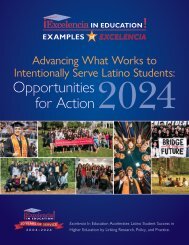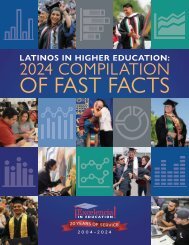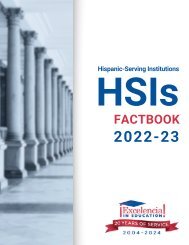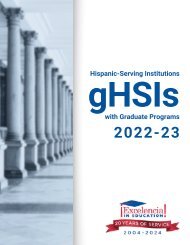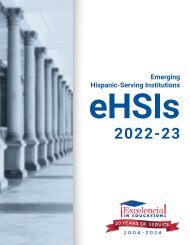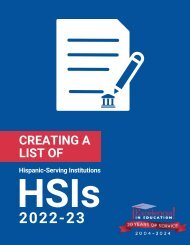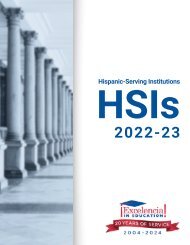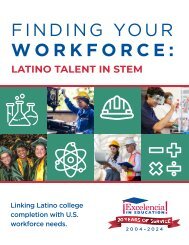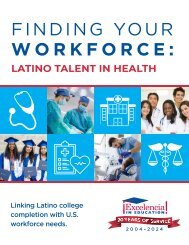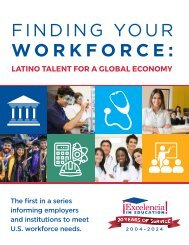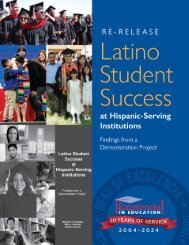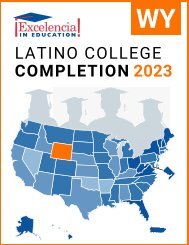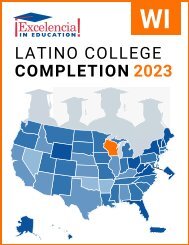Latino College Completion 2023: Georgia
You also want an ePaper? Increase the reach of your titles
YUMPU automatically turns print PDFs into web optimized ePapers that Google loves.
GA
LATINO COLLEGE COMPLETION:<br />
GEORGIA – <strong>2023</strong><br />
For the U.S. to regain the top ranking in the world for college degree<br />
attainment, <strong>Latino</strong>s will need to earn 6.2 million degrees by 2030. 1<br />
FAST FACTS<br />
STATE RANKING:<br />
<strong>Georgia</strong> had the 9th largest<br />
<strong>Latino</strong> population in the U.S.<br />
K-12 POPULATION:<br />
In <strong>Georgia</strong>, 14% of the K-12<br />
population was <strong>Latino</strong>. 2<br />
POPULATION:<br />
In <strong>Georgia</strong>, 10% of the population<br />
was <strong>Latino</strong>. 2<br />
MEDIAN AGE:<br />
The median age<br />
of Hispanics in<br />
<strong>Georgia</strong> was 27,<br />
compared to 42<br />
for White non-<br />
Hispanics. 2<br />
27<br />
Hispanics<br />
42<br />
White<br />
non-Hispanics<br />
ENROLLMENT:<br />
In <strong>Georgia</strong>, 21% of Hispanics<br />
(ages 18 to 34) were enrolled in<br />
higher education, compared to 22%<br />
of White non-Hispanics. 2<br />
DEGREE ATTAINMENT:<br />
In <strong>Georgia</strong>, 29% of Hispanic<br />
adults (25 and older) had earned an<br />
associate degree or higher, compared to<br />
46% of White non-Hispanic adults. 2<br />
Hispanic Adults = 2.9 of 10<br />
To reach the degree attainment goal by 2030, the U.S. can: close<br />
the degree completion gap by accelerating <strong>Latino</strong> completion while<br />
increasing for all students and scale up programs and initiatives that<br />
work for <strong>Latino</strong>, and all, students. The following demographics,<br />
institutional data, and practices inform <strong>Latino</strong> degree attainment.<br />
ENROLLING: Top 5 Institutions (Hispanic Undergraduates) in <strong>Georgia</strong>, 2021-22<br />
Institution<br />
Sector<br />
Grand<br />
Total<br />
NOTE: We use the terms <strong>Latino</strong> and Hispanic interchangeably in this factsheet.<br />
Hispanic<br />
Total<br />
Source: Excelencia in Education analysis using U.S. Department of Education, National Center for<br />
Education Statistics (NCES), Integrated Postsecondary Education Data System (IPEDS), 2021 Fall<br />
Enrollment, Graduation Rates Survey and Institutional Characteristics Survey.<br />
%<br />
Hispanic<br />
1 Kennesaw State University Public, 4-year 37,743 5,146 14%<br />
2 <strong>Georgia</strong> State University Public, 4-year 28,415 3,865 14%<br />
3 <strong>Georgia</strong> Gwinnett <strong>College</strong> Public, 4-year 10,377 2,662 26%<br />
4 University of North <strong>Georgia</strong> Public, 4-year 16,515 2,586 16%<br />
5 University of <strong>Georgia</strong> Public, 4-year 30,032 2,095 7%<br />
ASSOCIATE DEGREES: Top 5 Institutions Awarding to Hispanics in <strong>Georgia</strong>, 2020-21<br />
Institution<br />
Sector<br />
Grand<br />
Total<br />
Hispanic<br />
Total<br />
%<br />
Hispanic<br />
<strong>Georgia</strong> State University-<br />
1 Perimeter <strong>College</strong><br />
Public, 2-year 2,535 341 13%<br />
2 University of North <strong>Georgia</strong> Public, 4-year 781 153 20%<br />
3 <strong>Georgia</strong> Military <strong>College</strong> Public, 4-year 1,940 152 8%<br />
4 <strong>Georgia</strong> Highlands <strong>College</strong> Public, 4-year 877 116 13%<br />
5 Gwinnett Technical <strong>College</strong> Public, 2-year 739 106 14%<br />
BACHELOR DEGREES: Top 5 Institutions Awarding to Hispanics in <strong>Georgia</strong>, 2020-21<br />
Institution<br />
Sector<br />
Grand<br />
Total<br />
Hispanic<br />
Total<br />
%<br />
Hispanic<br />
1 <strong>Georgia</strong> State University Public, 4-year 5,370 644 12%<br />
2 Kennesaw State University Public, 4-year 5,922 585 10%<br />
3 University of <strong>Georgia</strong> Public, 4-year 7,896 522 7%<br />
4 <strong>Georgia</strong> Southern University Public, 4-year 4,247 274 6%<br />
<strong>Georgia</strong> Institute of Technology-<br />
5 Main Campus<br />
Public, 4-year 3,810 266 7%<br />
White Adults = 4.6 of 10<br />
1 Projections to 2030: Excelencia in Education. (2020). Ensuring America’s Future: Benchmarking <strong>Latino</strong><br />
<strong>College</strong> <strong>Completion</strong> to 2030. Excelencia in Education. Washington, D.C.<br />
2 U.S. Census Bureau, 2021 American Community Survey 1-Year Estimates
<strong>Georgia</strong> Gap in Degree <strong>Completion</strong><br />
Closing the degree completion gap can be tracked<br />
by the 4 measures shown below. Alone, none<br />
of these measures capture the entire “story” of<br />
degree completion. However, in combination,<br />
they provide a useful picture of the gap in degree<br />
attainment between Hispanic and White non-<br />
Hispanic cohorts in a single year.<br />
Graduation Rate — Total percentage of students<br />
who graduated within 150% of normal time for<br />
first-time, full-time freshmen. This incorporates<br />
students that graduated in 3 years at two-year<br />
institutions, or in 6 years at four-year institutions.<br />
Transferred to Another Institution —<br />
Percentage of students that transferred to another<br />
institution and did not complete a degree.<br />
Still Enrolled — Percentage of students that are<br />
still enrolled at the point of 150% normal time to<br />
completion.<br />
No Longer Enrolled — Percentage of students<br />
that are no longer enrolled at the point of 150%<br />
normal time to completion.<br />
At two-year institutions, Hispanics’<br />
graduation rate was the same as<br />
that of their White non-Hispanic<br />
peers in <strong>Georgia</strong>.<br />
TWO-YEAR INSTITUTIONS<br />
34%<br />
9%<br />
45%<br />
WHITE<br />
34%<br />
12% 13%<br />
DEGREE OUTCOMES<br />
■ No Longer Enrolled<br />
■ Still Enrolled<br />
At four-year institutions, Hispanics’<br />
graduation rate was 9%-points<br />
lower than that of their White<br />
non-Hispanic peers in <strong>Georgia</strong>.<br />
8% ■ Transferred to<br />
0% Another Institution<br />
-9%<br />
45%<br />
HISPANIC<br />
■ Graduation Rate<br />
*Percentages may not add up to 100% due to rounding.<br />
FOUR-YEAR INSTITUTIONS<br />
2%<br />
19%<br />
26%<br />
53%<br />
WHITE<br />
4%<br />
26%<br />
25%<br />
44%<br />
HISPANIC<br />
NOTE: Outcomes shown are for students at two-year institutions who started in Fall 2018, and<br />
for students at four-year institutions who started in Fall 2015.<br />
Source: Excelencia in Education analysis using the U.S. Department of Education, National<br />
Center for Education Statistics (NCES), Integrated Postsecondary Education Data System, 2021<br />
Graduation Rates Survey and the Institutional Characteristics Survey.<br />
Examples of What Works for <strong>Latino</strong> Students<br />
There are institutions showing success in enrolling, retaining, and graduating <strong>Latino</strong> students. The following are examples of<br />
programs across the country with evidence of effectiveness in serving <strong>Latino</strong> students nominated for Examples of Excelencia.<br />
The School of Science STEM Research Institute (SRI) at Miami Dade<br />
<strong>College</strong> provides Hispanic and other underrepresented STEM students<br />
high-quality, early research experiences to help them acquire knowledge<br />
and skills important to their academic success and competitiveness<br />
in the STEM workforce of the 21st century. The Institute seeks to<br />
increase persistence in STEM and attainment of STEM degrees among<br />
underrepresented students. Established in 2012, the Institute began<br />
as a pilot of undergraduate research. Aware that activities promoting<br />
deeper exposure to STEM have marked impacts on student success and<br />
retention, the Institute aimed to bring undergraduate research to the<br />
primarily Hispanic population of students at Miami Dade <strong>College</strong> (MDC).<br />
The School of Science STEM Research Institute requires students to<br />
complete 240 hours of research, attend professional skills workshops,<br />
and provide various deliverables. Participants typically engage in 10<br />
to 12 weeks of paid, high-level, and quality research experiences with<br />
faculty mentors and peers in interdisciplinary teams during the summer<br />
or as part of a year-round project. Program participants may choose<br />
to receive mentorship from MDC faculty or faculty at one of MDC’s<br />
partner research universities to carry out individual research projects.<br />
Over 75% of progam participants are Hispanic. For academic year 2019-<br />
2020, the fall-to-fall retention rate of SRI participants was 96% compared<br />
to 67% of STEM students who did not participate in undergraduate<br />
research experiences. In the past three years, 68% of participants<br />
graduated within 3 years compared to only 28% of non-participant STEM<br />
majors and 22% of non-STEM students at MDC. As of 2019, participants<br />
took an average of 2.8 years to graduate with an associate degree<br />
compared to 3.1 years for non-participant STEM students. As of 2020,<br />
students accomplished an average, 3.6 GPA compared to the average 2.8<br />
GPA of non-participant STEM students.<br />
For more information on institutional programs improving <strong>Latino</strong> student success in higher education, access Excelencia in<br />
Education’s Growing What Works database at http://www.edexcelencia.org/growing-what-works<br />
ENSURING AMERICA’S FUTURE BY INCREASING LATINO COLLEGE COMPLETION • WWW.EDEXCELENCIA.ORG




